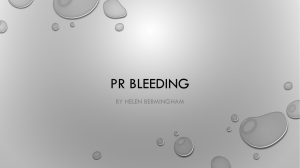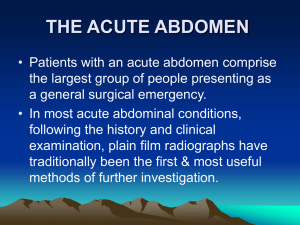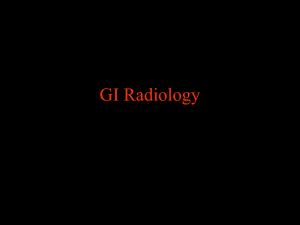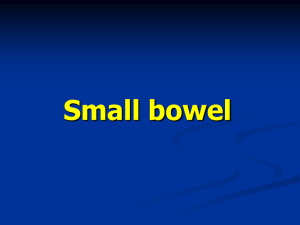randomized controlled trial
advertisement
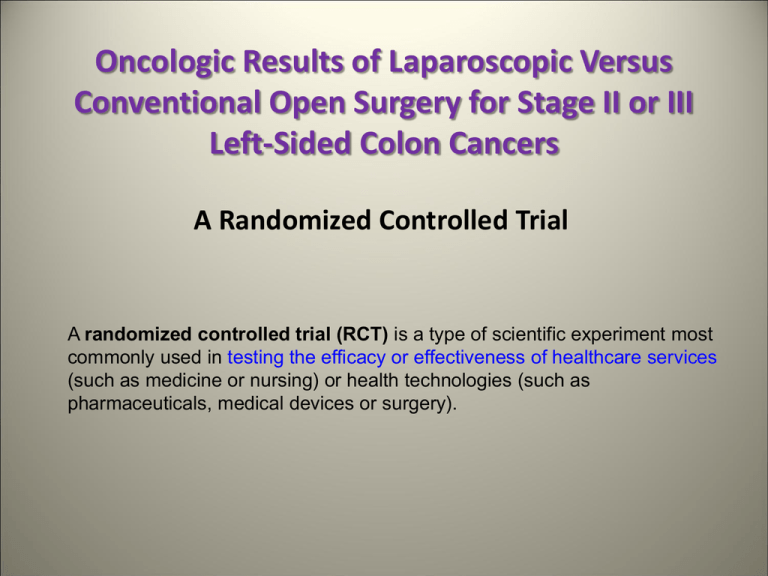
Oncologic Results of Laparoscopic Versus Conventional Open Surgery for Stage II or III Left-Sided Colon Cancers A Randomized Controlled Trial A randomized controlled trial (RCT) is a type of scientific experiment most commonly used in testing the efficacy or effectiveness of healthcare services (such as medicine or nursing) or health technologies (such as pharmaceuticals, medical devices or surgery). 3% 2% 5.5% 5% 4% 12% 21% 0.5% 38% 2% 4 stages of tumour size in colorectal cancer: T1 : the tumour is only in the inner layer of the bowel T2 : the tumour has grown into the muscle layer of the bowel wall T3 : the tumour has grown into the outer lining of the bowel wall or into organs or body structures next to the bowel T4 : into other parts of the bowel, other organs or body structures near to the bowel (such as the liver or small bowel), or the tumour has broken through the membrane covering the outside of the bowel (the peritoneum) 3 possible stages : cancer cells in the lymph nodes N0 : no lymph nodes containing cancer cells N1 : 1 to 3 lymph nodes close to the bowel contain cancer cells N2 : cancer cells in 4 or more lymph nodes that are further than 3cm away from the main tumour in the bowel OR there are cancer cells in lymph nodes connected to the main blood vessels around the bowel Two stages of cancer spread (metastasis): M0 : cancer spread to other organs M1 : cancer spread to other parts of the body Stages of colorectal cancer Stage 0 or carcinoma in situ (CIS): cancer cells all contained within the lining of the bowel. very little risk of any cancer cells having spread. very unusual for bowel cancer to be diagnosed this early Stage 1: cancer has grown through the inner lining of the bowel, or into the muscle wall but no further. There is no cancer in the lymph nodes (T1, N0, M0 or T2, N0, M0). Stage 2: Stage 2a : no cancer cells in the lymph nodes, but the cancer has broken through the outer covering of the bowel (T3, N0, M0) Stage 2b : cancer has grown through the outer covering of the bowel wall and into tissues or organs (T4) next to the bowel. But no lymph nodes are affected (N0) and the cancer has not spread to another area of the body (M0). Stage 3 Stage 3a : cancer is still in the inner layer of the bowel wall or has grown into the muscle layer, and between 1 and 3 nearby lymph nodes contain cancer cells (T1, N1, M0 or T2, N1, M0) Stage 3b : cancer has grown through the bowel wall or into surrounding body tissues or organs and between 1 and 3 nearby lymph nodes contain cancer cells (T3, N1, M0 or T4, N1, M0) Stage 3c : cancer can be any size, has spread to 4 or more nearby lymph nodes, but there is no cancer spread to any other part of the body (any T, N2, M0) Stage 4: cancer has spread to other parts of the body (such as the liver or lungs) through the lymphatic system or bloodstream (any T, any N, M1). Surgical Therapy Left sided lesions: ligation of the inferior mesenteric vessels or their branches. Splenic flexure cancers and cancers high in the left colon are often difficult to mobilise, particularly if they are large. Theoretically, anastomosis can be performed between the proximal transverse colon and proximal sigmoid colon, in reality this may be difficult and an ileosigmoid anastomosis may be necessary. Laparoscopic versus Open Resection Laparoscopic colon resection: first described in 1991 Less pain, more raped recovery. X early reports of recurrences at the site of port sites Ortega, 1995: a port site recurrence rate of 1.2% in 504 patients registered in The American Society of Colon and Rectal Surgeons database Multiple RCTs in Europe, S. America, Asia, Australia and N. America Results suggest LR takes longer to perform Hospital stay Pain and narcotic requirements Cost The evidence to date suggests that laparoscopic colectomy is an acceptable alternative to open surgery for colon cancer The medial approach : Division of the vascular pedicle first, followed by mobilization of the mesentery toward the abdominal wall, and finally freeing of the colon along the white line of Toldt. This approach allows immediate identification of the plane between the mesocolon and the retroperitoneum and renders the dissection fast and safe. 286 eligible patients Randomization 143 allocated to laparoscopic group 143 allocated to open group 8 excluded from analysis 9 excluded from analysis • 6 with metastatic disease detected intra-operatively • 2 withdrawn from study • 7 with metastatic disease detected intra-operatively • 2 withdrawn from study 4 patients converted •1 poor visualisation • 1 massive bleeding • 2 incomplete mobilisation 134 included in the intention-to-treat analysis 134 included in analysis Intention to treat analysis based on the initial treatment intent, not on the treatment eventually administered. to avoid the effects of crossover and drop-out, which may break the randomization to the treatment groups in a study. Intention to treat analysis provides information about the potential effects of treatment policy rather than on the potential effects of specific treatment. Conclusion With regard to the surgical treatment for Stage II or III left-sided colon cancers, the oncologic results for of laparoscopic approach were similar to those of traditional open surgery seeing that the extent of tumour extirpation and the tumour recurrence rate were the same in both methods. Thank You



